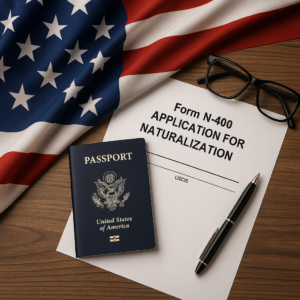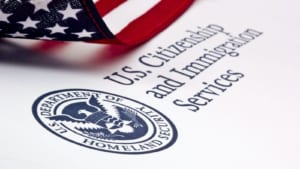
If you are applying for a U.S. immigrant visa, completing the online Form DS-260 is a major step in the immigration process once the United States Citizenship and Immigration Services approves your petition.
The DS-260 asks for detailed personal, family, and background information, which helps the United States Department of State (“DOS”) confirm your identity and eligibility. If the DS-260 is not properly completed, it can lead to the visa process being delayed.
At Enterline and Partners, we help clients avoid such roadblocks by making sure their DS-260 is accurate and complete from the start. In this guide, we’ll cover what the DS-260 is, when to file it, and the key things to keep in mind during the overall process.
When and How to Open Your DS-260
You will be able to begin your DS-260 once the National Visa Center (“NVC”) which is under DOS, confirms that your fees are paid and your Consular Electronic Application Center (“CEAC”) account updates to PAID status.
Once confirmed you will log into your CEAC account with your Case and Invoice number.
Keep these points in mind:
- Wait for PAID Status: The form will not unlock until your NVC fees are processed. The processing time for payment is normally 2-3 business days.
- Have Your Login Details Ready: You’ll need both your Case ID and Invoice ID to access your CEAC account.
- Save Often: The CEAC system times out quickly and unsaved information will be lost.
- Work in Sessions: Completing the form in smaller sections reduces mistakes.
Key Information Fields to Prepare
Because DS-260 requires more than just your basic identification, ensure that you have gathered the following details:
- Personal Details: Full legal name, date of birth, place of birth, and any other names you have used.
- Family and Relationships: Spouse, children, and parents’ information, which must align with your official documents.
- Employment History: Current and past employment, including job titles, employers, and dates of employment.
- Security and Background: Social media accounts from the past five (5) years, along with responses to background and security questions.

Rules and Best Practices When Completing the DS-260 Form
Following a few simple rules can prevent delays and complications later in the process. Our attorneys strongly advise the following:
- Use English Characters Only: The form does not accept accents, diacritics, or special symbols. All names and places need to be entered exactly as they appear in your official documents, but without added marks.
- Complete All Mandatory Fields: If a required question is left blank, the system will not let you proceed. Double-check each page before moving forward.
- Handle Optional Fields Carefully: If a question does not apply to you, select or write “Does Not Apply.”
- Be Consistent with Documents: Make sure every detail matches the records you’ll provide, from birthdates to employment history.
Completing this form correctly is one of the most important steps toward securing your immigrant visa. For personalized guidance from an experienced US immigration attorney, contact Enterline and Partners today.
What to Do After Submitting DS-260?
Once you submit the DS-260, you’ll receive a confirmation page with a unique barcode. Print this page and keep it safe as you must bring it to your visa interview.
It’s important to remember that submitting the form does not finalize your visa as you must be interviewed in person by a consular officer at a U.S. Embassy or Consulate.
Common Questions and Sensitive Scenarios We Encounter
Unfortunately, completing the DS-260 isn’t always a straightforward process for everyone. Applicants often encounter situations where small details can have big consequences.
Below are some of the most common and sensitive scenarios our attorneys have experienced, along with guidance on how to handle them.
Political Affiliations and Admissibility
One of the most delicate areas of the DS-260 involves political affiliations. For example, declaring membership in certain groups, such as the Communist Party, can trigger inadmissibility issues.
While the form requires truthful answers, immigrant visa applicants should understand the context of these questions and how their responses may affect the outcome.
If you are unsure about how to disclose past affiliations, speaking with an experienced U.S. immigration attorney before submission can help prevent avoidable complications.
Life Changes After Submission
Many applicants worry about what happens if their life circumstances change after they’ve already filed the DS-260. Common examples include:
- Marriage or Divorce;
- Birth or Adoption of a Child;
- Change of Address;
- New Employment Details.
In these cases, the form can be unlocked through either the NVC or, if your file is at your local U.S. Embassy or Consulate, through the appropriate consular department. However, this request must be done properly to avoid delays or confusion in your case file.
Incorrect or Incomplete Details
A frequent problem with the DS-260 is providing information that doesn’t match official records or leaving out details the form requires. This can cause questions during review or at the interview.
Common mistakes include:
- Misspelled names or use of nicknames instead of legal names;
- Wrong dates for birth, marriage, or employment;
- Missing previous addresses from the past five (5) years;
- Skipping short-term jobs or older employment history;
- Forgetting to list all social media accounts from the last five (5) years.
If you find yourself second-guessing any section of the form, consider working with a U.S. immigration lawyer for clear guidance.

DS-260 vs. DS-160
It’s easy to confuse the DS-260 with other immigration forms, but each serves a different purpose:
- DS-260: Used for immigrant visas, including family-based, employment-based, and Diversity Visa (“DV”) cases. This form is for applicants planning to live permanently in the United States.
- DS-160: Used for nonimmigrant visas, such as visitor/ tourist, student, or temporary work visas. Unlike the DS-260, this form does not establish permanent resident intent.
Don’t Risk Mistakes on Your Visa Application
At Enterline and Partners, we regularly handle DS-260 filings and completely understand the challenges immigrant visa applicants face. We know that getting this form right sets the stage for a smoother visa process.
If you feel uncertain about any part of the process, don’t leave it to chance. The immigration attorneys at Enterline and Partners can step in to make sure your DS-260 is done correctly the first time and help you approach the next stage confidently. Schedule a consultation today!
ENTERLINE & PARTNERS CONSULTING
Ho Chi Minh City, Vietnam Office
146C7 Nguyen Van Huong St, Thao Dien Ward,
District 2, Thu Duc City
Ho Chi Minh City, Vietnam
Tel: +84 933 301 488
Email: info@enterlinepartners.com
Facebook: Enterline & Partners – Dịch vụ Thị thực và Định cư Hoa Kỳ
YouTube: @EnterlineAndPartnersConsulting
Website: http://enterlinepartners.com
Manila, Philippines Office
LKG Tower 37th Floor
6801 Ayala Avenue
Makati City, Philippines 1226
Tel: +63 917 543 7926
Email: info@enterlinepartners.com
Facebook: Enterline and Partners Philippines
Website: https://enterlinepartners.com/language/en/welcome/
Copyright 2025. This article is for information purposes only and does not constitute legal advice. This article may be changed with or without notice. The opinions expressed in this article are those of Enterline and Partners only.



